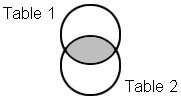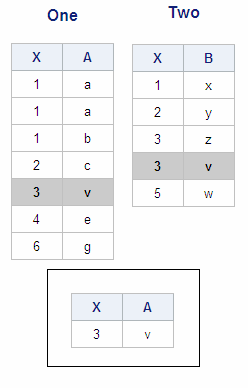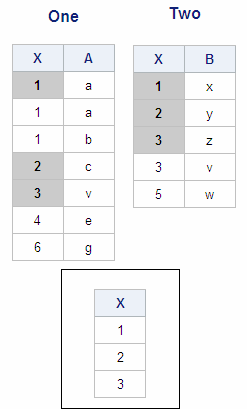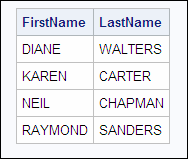Using the INTERSECT Set Operator
Using the INTERSECT Operator Alone
The INTERSECT operator
compares and overlays columns in the same way as the EXCEPT operator,
by column position instead of column name. However, INTERSECT selects
rows differently and is displayed in output the unique rows that are
common to both tables. The following PROC SQL set operation uses the
INTERSECT operator to combine the tables One and Two, which were introduced
previously:
Tables One and Two have
only one unique row in common and this row is displayed in the output.
(This is the same row that was eliminated in the earlier example that
contained the EXCEPT operator.)
Using the Keyword ALL with the INTERSECT Operator
Adding the keyword ALL to the preceding PROC SQL query
prevents PROC SQL from making an extra pass through the data. If there
were any rows common to tables One and Two that were duplicates of
other common rows, they would also be included in output. However,
as you have seen, there is only one common row in these tables. The
modified PROC SQL query, the tables One and Two, and the output are
shown below:
As before, there is
just one row of output.
Using the Keyword CORR with the INTERSECT Operator
To
display the unique rows that are common to the two tables based on
the column name instead of the column position, add the CORR keyword
to the PROC SQL set operation. The modified query, the tables One
and Two, and the output are shown below:
X is the only column
name that is common to both tables, so X is the only column that PROC
SQL examines and displays in the output. In the first pass, PROC SQL
eliminates the rows that are duplicated within each table: the second
and third rows in table One contain the same value for X as the first
row, and the fourth row in table Two contains the same value for X
as the third row. In the second pass, PROC SQL eliminates any rows
that are not common across tables: the fourth and fifth rows in table
One and the fifth row in table Two do not have a matching value of
X in the other table. The output displays the three rows with unique
values of X that are also common to both tables.
Using the Keywords ALL and CORR with the INTERSECT Operator
If
the keywords ALL and CORR are used together, the INTERSECT operator
displays all unique and nonunique (duplicate) rows that are common
to the two tables, based on columns that have the same name. The modified
query, the tables One and Two, and the output are shown below:
PROC SQL examines and
displays only the column with the same name, X. There are three common
rows across the two tables, which are highlighted above, and these
are the three rows that are displayed in the output.
Note that each of the
tables contains at least one other row that duplicates a value of
X in one of the common rows. For example, in the second and third
rows in table One, the value of X is 1, as in one of the common rows.
However, in order to be considered a common row and to be included
in the output, every duplicate row in one table must have a separate
duplicate row in the other table. In this example, there are no rows
that have duplicate values and that are also common across tables.
Therefore, in this example, the set operation with the keywords ALL
and CORR generates the same output as with the keyword CORR alone.
Example: INTERSECT Operator
Now that you have seen
how the INTERSECT set operator works with very small tables, we can
use INTERSECT in a realistic business problem. Suppose you want to
display the names of the existing employees who have changed their
salary or job code. (This query is the opposite of the query that
you solved with the EXCEPT operator.)
Once again, you use
the following tables.
|
Table
|
Relevant Columns
|
|---|---|
|
Sasuser.Staffchanges
lists information for all new employees and existing employees who
have had a change in salary or job code
|
FirstName, LastName
|
|
Sasuser.Staffmaster
lists information for all existing employees
|
FirstName, LastName
|
The relationship between
these two tables is shown in the diagram below:
As shown in the earlier
example with EXCEPT, the intersection of these two tables includes
information for all existing employees who have had changes in job
code or salary. It is the intersection of these two tables, shaded
above, that you want to display.
To display the unique
rows that are common to both tables, you use a PROC SQL set operation
that contains INTERSECT. It is known that these tables contain no
duplicates, so ALL is used to speed up query processing. The PROC
SQL set operation is shown below:
proc sql;
select firstname, lastname
from sasuser.staffchanges
intersect all
select firstname, lastname
from sasuser.staffmaster;Note: In this PROC SQL step, which
contains just one INTERSECT set operator, the order in which you list
the tables in the SELECT statement does not make a difference. However,
in a more complex PROC SQL step that contains multiple stacked INTERSECT
set operators, it is important to think through the table order carefully,
depending on when you want the non-matches to be eliminated. The output
shows that there are four existing employees who have changed their
salary or job code.
..................Content has been hidden....................
You can't read the all page of ebook, please click here login for view all page.






